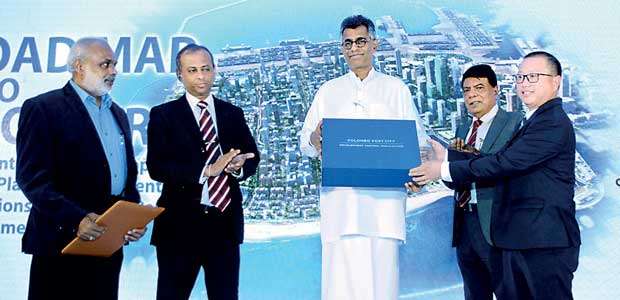12 Apr 2018 - {{hitsCtrl.values.hits}}

The Development Control Regulations of Colombo Port City prepared by Singapore’s Surbana Jurong and British firm Atikins being presented to Megapolis and Western Development Minister Patali Champika Ranawaka by Port City Colombo Managing Director Jiang Houliang in the presence of (from left) Port City Project Director Nihal Fernando, Megapolis and Urban Development Authority Chairman Dr. Jagath Munasinghe and Western Development Ministry Secretary Engineer Nihal Rupasinghe
Pic by Pradeep Pathirana
CHEC Port City Colombo this week hosted its future utility partners, representatives from allied government agencies and prospective investors to an event themed ‘Roadmap to Prosperity’, held at The Kingsbury, to present the project’s Development Control Regulations (DCR).
Surbana Jurong, one of Asia’s largest urban, industrial and infrastructure consulting firms based in Singapore and Atkins, the UK’s largest engineering consultancy, were brought on board by the project company to prepare the DCR to the existing Master Plan, which was originally done by Swedish-based planning consultant, SWECO.
The DCR was first presented to Megapolis and Western Development Minister Patali Champika Ranawaka and the Urban Development Authority for appraisal.
It provides a clear mechanism for the implementation of the Master Plan and directs both public and private sector developments with a set of development objectives, definitions and regulations. The regulations are essential to enforce the vision and objectives of the Master Plan in a transparent manner.
According to the Singapore-based consultant, they have taken the key essence of the previous Master Plan and refined it further through urban design guidelines, in preparing the DCR for the Port City.
“The soul of the project is sustainability and quality lifestyle. The urban structure of the Port City is designed for liveability, social security, tolerance and inclusion, thereby contributing to a higher quality of life. It emphasises a well-balanced relationship between the public, semi-public and private realms, where different kinds of spaces give rise to a wide range of uses and activities,” said Surbana Jurong GCEO Wong Heang Fine.
The Port City Colombo would be an extension of the existing city’s Central Business District (CBD), with five new districts i.e. the Financial District, Marina, International Island, Central Park Living and Island living. Each district offers a good mix of uses, which allow for a ‘live + work + play’ environment.
Parks and open spaces, waterfront promenades, public plazas and active street edges all along the central boulevard allow for recreational facilities within walking distances and promote a healthy lifestyle that will appeal to all ages and all people, who aspire to live in the heart of the city. The development control regulations are crafted very carefully to create a more connected community with provision for spaces for people to interact and socialise in. Planning would create a robust economy and superior quality of life for the Port City’s residents in an environmentally sustainable manner, while the differentiator would be the resolve to set up a clear implementation process for enforcement, such as the DCR. Clear regulations for all parties involved would work towards delivering a world-class city.
The Colombo Port City Development Project (CPCDP) DCR is organised within a framework of four volumes, which cover four key areas, i.e. urban design, utility, landscape and sustainability. The strategies for development are described and then translated to mandatory plot-level regulations for developers to follow. The DCR will also provide detailed land use and development regulations for all development partners of the Port City, including architects, designers, builders and developers, who will contribute to the realisation of the desired vision and character for the new city.
A number of sustainability objectives are defined in the DCR, as overall guidance for mandatory requirements. The requirements outline the minimum level of performance required, in some cases raising the bar above the threshold level required by internationally recognised certification schemes, such as LEED, BREEAM and Green Mark, whose mandatory requirements have been established based on over a 100 individual performance criteria.
Sustainable solutions to reduce net water consumption through the implementation of water conservation measures and use of low water consumption fixtures, fittings and equipment have been included, whilst the use of renewable energy solutions, methods to enhance environmental quality, recycling of wastewater and disposal, improved public space and sustainable transport methods, etc. have been taken into account and clear solutions included.
18 Nov 2024 4 hours ago
18 Nov 2024 5 hours ago
18 Nov 2024 5 hours ago
18 Nov 2024 7 hours ago
18 Nov 2024 18 Nov 2024